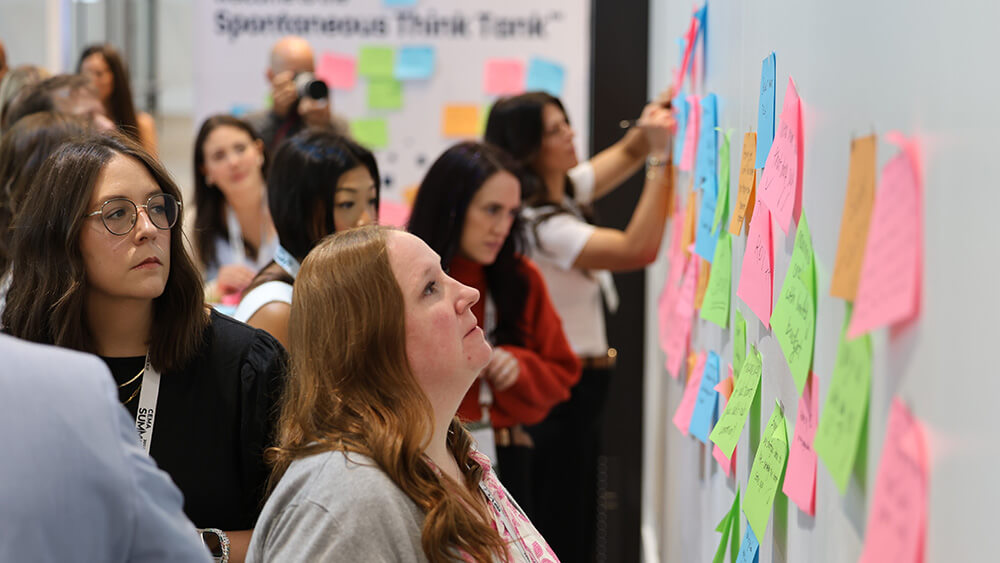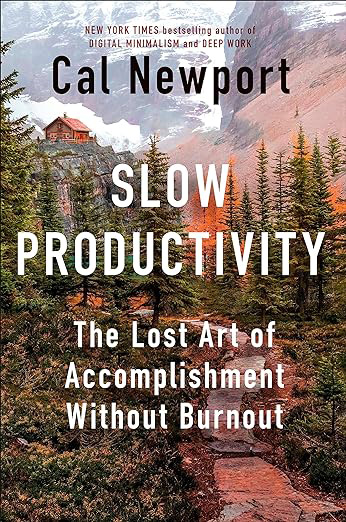
CEMA Summit attendees use sticky notes during a Spontaneous Think Tank session in August. (Whatever Media Group)
In his latest book, Slow Productivity: The Lost Art of Accomplishment Without Burnout, Georgetown University computer science professor Cal Newport talks about a “fascinating case study” that he came across in the MIT Management Review. It was about a team of IT professionals responsible for building novel digital tools to help the scientists at the Broad Institute of MIT and Harvard in Cambridge, Massachusetts.
I was immediately drawn to how they resolved their challenges by using an analog approach — using Post-it notes on a wall, yet another example of the power of such a deceptively simple tool in group settings.

In his latest book, Cal Newport discusses how readers can limit the volume of their productivity to a sustainable level.
This is something we’ve written about often in Convene. Sticky notes, Storycraft Lab’s Naomi Clare told Convene, are great for brainstorming, forcing us to “get out of own heads — where we are likely constructing a more complex narrative — and break our logic down into small bite-sized thoughts.”
During “connection sessions” at Exponent Philanthropy’s annual conference, for example, participants wrote down responses to questions — like recalling a practice that changed for them over the past year — on Post-it notes, the organizer told Convene. The notes were tacked onto a wall where they were grouped into categories for all participants to view.
Overload Prevention
But back to the Broad Institute example: The IT team “had many more ideas for tech development under consideration than it could fully investigate and many more projects underway than its overloaded operations team could ever implement,” the authors of the MIT case study wrote. Sound familiar?
The engineers kept coming up with new ideas and “the system soon became bogged down by its own excessive ambition,” Newport writes. “If a project was deemed particularly vital, it would be ‘expedited,’ leaving the team to ‘drop everything and fight the new fire.’ The individual engineers found themselves frantically juggling more projects than they could handle, with new priorities constantly arriving, and demands for their attention shifting unpredictably.”
Again: Sound familiar? Having to manage constantly shifting priorities was a frequent complaint voiced by planner respondents to our most recent Salary Survey.
The engineers “wanted to transition from a system in which new tasks could be pushed onto their plate haphazardly to one in which they would pull in new work only when they were ready for it,” Newport said.
To accomplish this — remember that these are IT professionals who, I can imagine, would easily be comfortable working with an online task-management platform — “they sketched a diagram on some unused wall space” in their office. Included in the diagram was a box for each step of their design process, from original idea all the way through to testing and deployment.
“Specific projects were represented by Post-it notes stuck on the wall in the box corresponding to the current stage in this process,” Newport explains. “Each of these notes was labeled with the names of the engineers who were working on it, making it clear exactly what everyone was currently up to.”

Cal Newport
Once a week, the group would meet to discuss the status of each Post-it note, he writes in Slow Productivity. “If a project was ready to advance to the next stage, the team leader would need to identify engineers with enough spare capacity to take it on. Their names would be added to the note, which would then be moved to the next box.”
This method made it easy to identify in one fell swoop if a project was stalled: Its note would have stopped moving along to the next phase. The decision was then made whether any members of the team had the capacity to move it along or if the project should be scrapped altogether.
The genius of this system is that it prevented, via group consensus, “an unbounded amount of work from being pushed onto any individual’s plate,” Newport noted. A team member could only pull in new work if they had the sufficiency — which was easy to see by “surveying how often their name came up on the wall.”
Overload, Newport writes, became “impossible.” The pull strategy resulted cutting in half the total number of projects underway in the tech development group, “while the rate at which projects were completed notably increased.”
Listen to Newport read this section of Slow Productivity at the Next Big Idea Club.
Michelle Russell is editor in chief of Convene.
